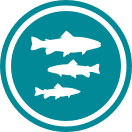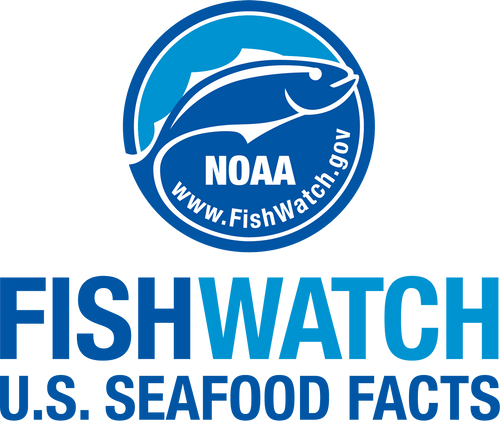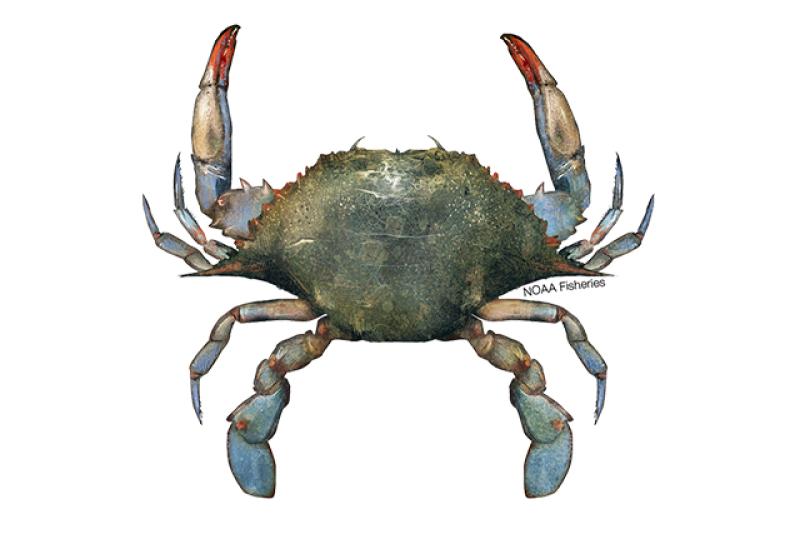Atlantic Deep-Sea Red Crab
 Deep-sea red crab (Chaceon quinquidens) is commercially fished with traps and very numerous on the continental slope at depths between 200 and 1800 meters from the Gulf of Maine to the Gulf of Mexico. Credit: NOAA Fisheries/Vince Guida
Deep-sea red crab (Chaceon quinquidens) is commercially fished with traps and very numerous on the continental slope at depths between 200 and 1800 meters from the Gulf of Maine to the Gulf of Mexico. Credit: NOAA Fisheries/Vince Guida
Deep-sea red crab (Chaceon quinquidens) is commercially fished with traps and very numerous on the continental slope at depths between 200 and 1800 meters from the Gulf of Maine to the Gulf of Mexico. Credit: NOAA Fisheries/Vince Guida
About the Species
 Deep-sea red crab (Chaceon quinquidens) is commercially fished with traps and very numerous on the continental slope at depths between 200 and 1800 meters from the Gulf of Maine to the Gulf of Mexico. Credit: NOAA Fisheries/Vince Guida
Deep-sea red crab (Chaceon quinquidens) is commercially fished with traps and very numerous on the continental slope at depths between 200 and 1800 meters from the Gulf of Maine to the Gulf of Mexico. Credit: NOAA Fisheries/Vince Guida
Deep-sea red crab (Chaceon quinquidens) is commercially fished with traps and very numerous on the continental slope at depths between 200 and 1800 meters from the Gulf of Maine to the Gulf of Mexico. Credit: NOAA Fisheries/Vince Guida
The Atlantic deep-sea red crab fishery is managed in the U.S. from roughly the latitude of Cape Hatteras Lighthouse, North Carolina, northward to the U.S./Canada border, extending eastward from the shore to the outer boundary of the exclusive economic zone and northward to the U.S./Canada border. The directed fishery is conducted year-round, uses trap/pot gear, and takes place primarily between 400 to 800 meters along the continental shelf. The market for red crab is picked and packaged crab meat for human consumption. Implementing regulations are found at 50 CFR part 648 subpart M.

Population
The stock has not been assessed. Although the population level is unknown, management measures are in place.

Fishing Rate
Not subject to overfishing.

Habitat Impact
Traps used to harvest deep-sea red crab have minimal impacts on habitat.

Bycatch
Bycatch is low because trap/pot gear is selective, and the presence of other species is low because of the depths where red crabs are found.
Population Status
Atlantic deep-sea red crab was assessed in 2023, but the stock assessment did not provide information to determine the population status so it is unknown. There are currently no indications that the stock is overfished. Summary stock assessment information can be found on Stock SMART.
Every 4 years, new information is reviewed to assess stock indicators. These indicators have been stable over time and recent landings have been at or below the quota.
Appearance
Atlantic deep-sea red crabs are large bright red crabs with a square carapace.
They have long legs that extend to the side, so that the entire width of the crab is double the width of the carapace.
Biology
Atlantic deep-sea red crab females reach up to 5¼ inches (13.3 cm) carapace width and males reach 6.5 inches (16.5 cm). They reach maturity at less than 4 inches (10.2 cm) carapace width. Mating occurs after the female has molted, with the male carrying the smaller female beneath him for up to several days. They live in a food-limited environment and likely eat a wide range of invertebrates, as well as scavenge carcasses. There is very limited information on growth rate or maximum age.
Where They Live
Range
Along the eastern United States, red crabs are found from Nova Scotia to North Carolina. They are also found in the Gulf of Mexico.
Habitat
Atlantic deep-sea red crab live in very deep, cold waters on the ocean bottom. Bottom habitat consists of smooth, silty ocean bottom, as well as rocky canyons. Light and plant life are scarce, and food is limited.
Fishery Management
NOAA Fisheries and the New England Fishery Management Council manage the Atlantic deep-sea red crab fishery.
Atlantic deep-sea red crab is managed under the Atlantic Deep-Sea Red Crab Fishery Management Plan which includes:
- Permitting requirements for commercial vessels.
- Limited to five permitted vessels that fish exclusively in federal waters. Typically only three to four vessels are active.
- Trap configuration and gear marking requirements.
- Annual catch limits for commercial catch, based on best available science.
- Fishing season that runs from March 1 through the end of February.
Harvest
In 2022, commercial landings of Atlantic deep-sea red crab totaled 1,999.4 mt (4,408,055 lb, according to the final 2022 fishing year quota monitoring report. The majority of landings are from the Northeast and Mid-Atlantic.
Commercial fishermen use conical, or cone-shaped, pots that are wider at the base than the top. The gear consists of up to 150 baited crab pots in a string, and each permitted vessel is limited to fishing 600 pots. Landings of red crab are driven by market demand which can be variable. There is limited bycatch of other species in the red crab fishery.
Scientific Classification
Along the eastern United States, red crabs are found from Nova Scotia to North Carolina. They are also found in the Gulf of Mexico.
Atlantic deep-sea red crab live in very deep, cold waters on the ocean bottom. Bottom habitat consists of smooth, silty ocean bottom, as well as rocky canyons. Light and plant life are scarce, and food is limited.
Fishery Management
NOAA Fisheries and the New England Fishery Management Council manage the Atlantic deep-sea red crab fishery.
Atlantic deep-sea red crab is managed under the Atlantic Deep-Sea Red Crab Fishery Management Plan which includes:
- Permitting requirements for commercial vessels.
- Limited to five permitted vessels that fish exclusively in federal waters. Typically only three to four vessels are active.
- Trap configuration and gear marking requirements.
- Annual catch limits for commercial catch, based on best available science.
- Fishing season that runs from March 1 through the end of February.
Harvest
In 2022, commercial landings of Atlantic deep-sea red crab totaled 1,999.4 mt (4,408,055 lb, according to the final 2022 fishing year quota monitoring report. The majority of landings are from the Northeast and Mid-Atlantic.
Commercial fishermen use conical, or cone-shaped, pots that are wider at the base than the top. The gear consists of up to 150 baited crab pots in a string, and each permitted vessel is limited to fishing 600 pots. Landings of red crab are driven by market demand which can be variable. There is limited bycatch of other species in the red crab fishery.
Scientific Classification
| Kingdom | Animalia | Phylum | Arthropoda | Class | Malacostraca | Order | Decapoda | Family | Geryonidae | Genus | Chaceon | Species | quinquedens |
|---|
Last updated by NOAA Fisheries on 09/06/2024
Featured News
Recreational Fishing Regulations
There are currently no recreational possession restrictions for red crab caught in federal waters. Recreational anglers must still comply with minimum fish size regulations for all recreational fisheries.
Recreational anglers will need to get a general recreational fishing license either through your state or through NOAA Fisheries to fish recreationally for marine species. Visit our permit office or recreational fishing pages for more information.
Reporting A Recreational Catch
Not applicable for the deep-sea red crab fishery. Visit the Greater Atlantic Region's recreational fishing page for more information about recreational reporting requirements in general.
More Information
Last updated by NOAA Fisheries on 09/06/2024
Commercial Fishing Regulations
Possession and Size Requirements
The federal possession limits for deep-sea red crab are dependent on the type of permit:
- Open access permits have a possession limit of 500 lb.
- Limited access permits do not have a federal possession limit.
There are no federal size limit requirements in the commercial red crab fishery.
Female Red Crab Restriction: No vessel may catch, possess, transport, land, sell, trade, or barter, female red crabs in excess of one standard tote (~100 lb) of incidentally caught female red crabs per trip.
Processing At-Sea Restriction: No vessel may fully process red crab while at sea.
Mutilation Restrictions: In addition, no vessel on a dedicated red crab trip may possess red crab claws and legs separate from red crab bodies, in excess of one standard tote (~100 lb). Vessels fishing under the open access regulations (open access permitted vessels or limited access permitted vessels fishing for red crab incidentally) may not possess any red crab claws or legs separate from red crab bodies and may not possess more than two claws and eight legs per red crab body.
Current Atlantic Deep-Sea Red Crab Specifications (March 1, 2024 to February 28, 2025)
| Overfishing Limit (OFL) | Unknown |
|---|---|
| Acceptable Biological Catch (ABC) | 4.41 million lb |
| Annual Catch Limit (ACL) | 4.41 million lb |
| Annual Catch Target (ACT) | Not Applicable |
| Total Allowable Landings (TAL) | 4.41 million lb |
| Optimal Yield (OY) | Unknown |
Reporting A Commercial Catch
Catch Reporting and Vessel Trip Reports (VTR)
Owners/operators of vessels holding a federal deep sea red crab permit must submit VTRs electronically. For more information about trip reporting and to see a list of approved eVTR software applications, please visit the Greater Atlantic Region vessel trip reporting page.
Other Reporting Information
The commercial red crab fishery does not have any Interactive Voice Response (IVR), Vessel Monitoring System (VMS), or specific observer requirements. However, all federally permitted vessels are obligated to carry an observer if randomly selected by the National Observer Program.
Commercial Gear Information
Red crab traps/pots are defined as “any structure or other device, other than a net or parlor trap/pot, that is placed, or designed to be placed, on the ocean bottom and is designed for, or is capable of, catching red crabs.”
Commercial Gear Requirements for Atlantic Deep-Sea Red Crab
- Limited access red crab vessels may fish with or carry on board up to a total of 600 traps/pots when fishing for red crab.
- Each trap may not be larger than 18 cubic feet, and they may be rectangular, trapezoidal, or conical only, unless otherwise allowed by the Regional Administrator.
- No one may haul or remove lobster, red crab or fish from parlor traps/pots when fishing on a dedicated red crab trip.
- Red crab traps/pots, fished in 200 fathoms (365.8 m) or less by a vessel issued a limited access lobster permit, must comply with the lobster trap tagging requirements.
Gear Markings
- All buoys used at the end of each red crab trawl must have the letters “RC” painted on the top of each buoy.
- The vessel's permit number must be painted on the side of each buoy to clearly identify the vessel.
- The number of each trap trawl, relative to the total number of trawls used by the vessel (i.e. “3 of 6”) must be painted on the side of each buoy. The letters and numbers must be at least 3 inches (7.62 cm) in height.
- Each trap trawl is required to have high flyers and radar reflectors.
Last updated by NOAA Fisheries on 09/06/2024
Seafood Facts

U.S. wild-caught Atlantic deep-sea red crab is a smart seafood choice because it is sustainably managed and responsibly harvested under U.S. regulations.
Availability
Year-round.
Source
Wild-caught from North Carolina to Massachusetts.
Taste
Sweet and clean.
Texture
Delicate.
Color
White with a pink hue.
Health Benefits
Atlantic deep-sea red crab is a great, low-fat source of protein and is low in saturated fat.
Nutrition Facts
Servings: 1; Serving Weight: 100 g (raw); Calories: 81; Protein: 18.6 g; Total Fat: 0.81 g; Total Saturated Fatty Acids: 0.090 g; Carbohydrate: 0 g; Total Sugars: 0 g; Total Dietary Fiber: 0 g; Cholesterol: 114 mg; Selenium: 45.8 mcg; Sodium: 331 mgMore Information
Last updated by NOAA Fisheries on 09/06/2024
Seafood News
 Credit: NOAA Fisheries/Brianna Shaughnessy
Credit: NOAA Fisheries/Brianna Shaughnessy
 An oyster reef with lush greenery in the background. Credit: Adobe Stock
An oyster reef with lush greenery in the background. Credit: Adobe Stock
 A fisherman unloading their catch at dock. Credit: NOAA Fisheries
A fisherman unloading their catch at dock. Credit: NOAA Fisheries
Management Overview
The red crab fishery is managed by the New England Fishery Management Council, and NOAA Fisheries implements the regulations.
The fishery is managed using a total allowable landings limit (quota), within an annual catch limit; and accountability measures framework. Only male crabs are allowed to be harvested. There are also limited access and open access permits within the fishery with different possession limits.
The fishing year runs from March 1 through the end of February, and there are no specified management areas for the fishery; with NOAA Fisheries Greater Atlantic Region jurisdiction covering the area of the Atlantic Ocean from 35° 15.3' N. Lat., the approximate latitude of Cape Hatteras Light, North Carolina, northward to the U.S.-Canada border, extending eastward from the shore to the outer boundary of the exclusive economic zone and northward to the U.S.-Canada border.
Control Date for the Deep-Sea Red Crab Fishery: March 1, 2000
Specifications/Quotas
The Deep-Sea Red Crab Fishery Management Plan requires the specification of catch and harvest limits for up to four years at a time. If specifications are not in place at the start of the fishing year, the existing specifications roll over until new regulations are finalized. Please check the Atlantic deep-sea red crab commercial fishing page for current specifications.
Inseason Actions
When the total allowable landings is projected to be harvested, the Regional Administrator will reduce the red crab possession limit to 500 lb, for all vessels, including limited access vessels.
Accountability Measures (AM)
If the red crab total allowable landings (TAL)/annual catch limit (ACL) is exceeded, then a pound-for-pound deduction will be taken from the next year’s TAL/ACL.
Regulatory History
- 2024 – Four-year specifications were approved for 2024–2027 based on the results of the 2023 management track assessment update for the red crab fishery and the recommendations of the Council’s Scientific and Statistical Committee (SSC). The recommended specifications maintain status quo specifications from fishing years 2020 through 2023. Recent landings, landings per unit of effort, the size of port-sampled crabs, discard information, and economic data suggest there has been no change in the size of the red crab stock since Amendment 3 was implemented in 2011.
- 2020 – Four-year specifications were implemented for 2020–2023 based on the results of the most recent peer-reviewed assessment of the red crab fishery carried out by the Data Poor Stocks Working Group in 2009 and the recommendations of the Council’s SSC. The recommended specifications include a 12.7 percent increase for 2020–2023 when compared to the previous specifications. The Council and its SSC asserted that the increased catch limit will not result in overfishing and adequately accounts for scientific uncertainty due to past performance of underharvesting past specifications. Recent landings, landing per unit of effort, port samples, discard information, and economic data suggest there has been no change in the size of the red crab stock since Amendment 3 was implemented in 2011.
- 2018 – Amendment 2 implemented revisions to regulations for essential fish habitat designations and protections. The measures are designed to minimize to the extent practicable the adverse effects of fishing on essential fish habitat.
- 2017 – Three-year specifications were implemented for 2017–2019 using the recommended status quo Acceptable Biological Catch (ABC) equal to the long-term average landings of the directed red crab fishery for fishing years 2014–2016. Due to the data poor nature of the fishery, the Council agreed with the conclusion that historical landings of male red crab and historical discarding practices appear to be sustainable for the time being, and that an interim ABC based on long-term average landings is safely below an undetermined overfishing threshold and adequately accounts for scientific uncertainty. These specifications maintained a TAL at the same levels already in effect under Amendment 3.
- 2015 – Amendment 4 implemented Standardized Bycatch Reporting Methodology.
- 2013 – Three-year specifications were implemented for 2014–2016 using the recommended status quo ABC equal to the long-term average landings of the directed red crab fishery for fishing years 2011–2013. Due to the data poor nature of the fishery, the Council agreed with the conclusion that historical landings of male red crab and historical discarding practices appear to be sustainable for the time being, and that an interim ABC based on long-term average landings is safely below an undetermined overfishing threshold and adequately accounts for scientific uncertainty. These specifications maintained a TAL at the same levels already in effect under Amendment 3.
- 2011 – Amendment 3 established ACLs and accountability measures for the fishery, and eliminated days-at-sea (DAS) and trip limits for the limited access red crab fleet. The target total allowable catch (TAC) was changed to a TAL by this rule. Amendment 3 also established a TAL of 3.91 million lb for the 2011–2013 fishing years.
- 2010 – The Council submitted specifications for the 2010 fishing year that were the same as those implemented in the emergency rule. However, prior to the implementation of the final rule, the Council’s SSC recommended an adjustment to the Council’s recommended specifications. NOAA Fisheries did not have the regulatory authority to alter the specifications in the final rule, so the originally proposed specifications (3.56 million lb/582 fleet DAS) were implemented. However, an in-season adjustment was implemented by the Regional Administrator at the request of the Council. The in-season adjustment increased the target TAC to 3.91 million lb and the fleet DAS allocation to 665.
- 2009 – NOAA Fisheries implemented emergency measures to address the Data Poor Stocks Working Group’s recommendations for reduced catch while the Council developed specifications for the 2010 fishing year. The emergency measures reduced the target TAC to 3.56 million lb (from 5.928 million lb) and the fleet DAS allocation to 582 (from 780 fleet DAS).
- 2008 – The Northeast Fisheries Science Center conducted a stock status review under the Data Poor Stocks Working Group, which recommended a reduced catch limit for the red crab fishery.
- 2007 – Amendment 1 standardized bycatch reporting methodology.
- 2005 – Framework 1 established a multi-year specifications process and continued the same target TAC (5.928 million lb) and DAS allocations (780 fleet DAS) as the previous years.
- 2002 – Atlantic Deep-Sea Red Crab fishery management plan implemented. The FMP included limited access permit qualification criteria, a target TAC limit, trip limits, trap limits, a DAS system that equally distributes the DAS across the fleet, a prohibition on landing female red crab, and an annual specifications process.
- 2001 – Emergency measures implemented to prevent overfishing while the Council developed an FMP. These emergency measures were in effect from mid-2001 until late 2002, when they were replaced by the FMP.
- 2000 – Industry requested the Council to develop a limited access management plan due to concerns about the increased number of vessels targeting red crab.
Last updated by NOAA Fisheries on 09/06/2024
Science Overview
Red Crab Stock Status Information
Very little is known about the life history and stock status of deep-sea red crab, but the New England Fishery Management Council’s Scientific and Statistical Committee (SSC) has recommended that the long-term average landings by the directed red crab fleet appears to be sustainable. Even though the overfishing limit is unknown, the SSC considers long-term average landings to be sufficiently below whatever that value is likely to be. Unlike most fisheries, no reliable discard estimate could be determined for red crab. Therefore, the acceptable biological catch, annual catch limit, and total allowable landings are currently all equal to the long-term average landings of male crabs.
For detailed information about stock status, management, assessments, and resource trends, you can search for red crab, and any other species of interest, using NOAA’s StockSMART web tool.
More Information
Recent Science Blogs
Last updated by NOAA Fisheries on 09/06/2024
Outreach & Education
Fisheries of the Northeast
More than 100 species, including finfish, shellfish, urchins, and seaweeds, are landed in the…
Last updated by NOAA Fisheries on 09/06/2024









